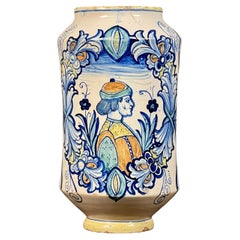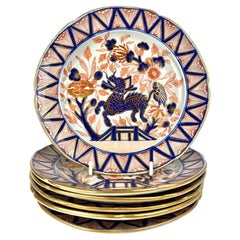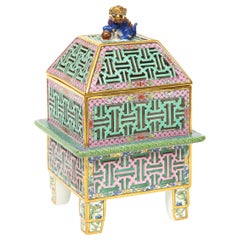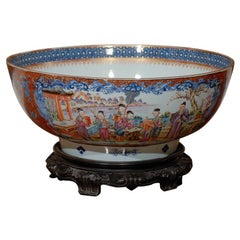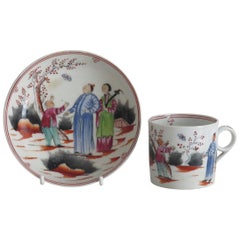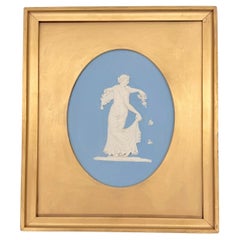Late 18th Century Ceramics
to
11
103
424
1,422
6,897
1,811
944
4,165
1,093
123
39
278
361
203
850
1,113
506
191
73
21
19
16
3
1
1
102
40
32
25
11
54
39
89
45
41
28
11
103
103
103
11
9
8
7
2
Period: Late 18th Century
18th Century Italian Majolica Vase Albarello
Located in Roma, IT
Antique Savona Ceramic Albarello, 18th Century
Beautiful polychrome painted majolica tree, cylindrical body with rounded shoulders from which rises a sma...
Category
Italian Louis XIV Antique Late 18th Century Ceramics
Materials
Majolica
Cabinet Set Six Imari Dessert Plates with Dragons 18th Century Turner's Patent
By John Turner
Located in Katonah, NY
This set of six plates, crafted by John Turner around 1795, features the exquisite Imari color palette of iron red, cobalt blue, and radiant gold. The color combination creates a vib...
Category
English Chinoiserie Antique Late 18th Century Ceramics
Materials
Ironstone
Rare Meissen Marcolini Porcelain Chinoiserie Incense Burner Vase and Cover
Located in Queens, NY
A rare Meissen Marcolini Porcelain Chinoiserie incense burner vase and cover, made for the Chinese market, circa 1800, blue cross swords and star mark, Pressnummer 58
A Museum Quality Piece.
Painted in the sought after famille rose palette with sprigs of indianische Blumen and enriched in gilding, the simulated pierced body supported by four feet painted with stylized dragons, the pierced cover with a Buddhist lion finial.
10" high x 6" wide x 6" deep
The shape of this piece, which appears to be unrecorded in the literature, is inspired by similar Chinese porcelain censers from the Qing Dynasty, Kangxi Period (1654-1722). An example in the Palace Museum, Beijing, is illustrated by Li Yi-hua in Qing Porcelain of Kangxi, Yongzheng and Qianlong Periods from the Palace Museum Collection, Hong Kong, 1989, pl. 65. Another in the British Museum, London (museum no. PDF, A.812) is catalogued as a perfume-holder.
These porcelain examples are in turn inspired by ancient Chinese bronzes from both the Shang (1600-1046 BC) and the Zhou (1046-246 BCE) dynasties, an example of which was sold anonymously by Christie's New York, 22 March 2019, lot 1601. This chain of inspiration tracking backwards from the 19th century to antiquity provides a clear example of how ceramics, and indeed other mediums, are able to influence and motivate the works of later generations.
For a Meissen porcelain snuff...
Category
German Chinoiserie Antique Late 18th Century Ceramics
Materials
Porcelain
Large Chinese Export Punch Bowl, Painted & Gilt Decoration in Mandarin Palette
Located in Atlanta, GA
Large & Very Fine Chinese Export Punch Bowl, with Painted & Gilt decoration in the Mandarin palette. Jingdezhen region, China ca. 1780.
Category
Chinese Chinese Export Antique Late 18th Century Ceramics
Materials
Porcelain
Early New Hall Porcelain Coffee Can & Saucer Duo Chinese Pattern 421, circa 1800
By New Hall
Located in Lincoln, Lincolnshire
This is a hard paste porcelain coffee can & saucer duo by New Hall, hand decorated with their Chinese figure pattern number 421, dating to the English George 3rd...
Category
English Chinoiserie Antique Late 18th Century Ceramics
Materials
Porcelain
18th Century Wedgwood & John Flaxman, Blue Jasperware "Dancing Hours" Plaque
Located in West Palm Beach, FL
18th Century Wedgwood & John Flaxman, Blue Jasperware "Dancing Hours" Plaque, England, circa 1790
This exquisite late 18th-century Wedgwood blue jasperware plaque from the "Dancing ...
Category
Antique Late 18th Century Ceramics
Materials
Ceramic, Giltwood
$1,036 Sale Price
20% Off
Worcester Barr Period Porcelain Coffee Cup in Royal Lily pattern, circa 1800
Located in Lincoln, Lincolnshire
This is a very good hard paste porcelain early Coffee Can or cup with a loop handle, hand decorated in the Royal Lily pattern by Worcester during the Barr p...
Category
English George III Antique Late 18th Century Ceramics
Materials
Porcelain
Remarkable 18th Century Footed Slipware Colander
Located in Pease pottage, West Sussex
18th Century Slipware colander, three integrated feet, yellow slip. lots of wear.
France, Circa 1760.
Category
French Antique Late 18th Century Ceramics
Materials
Stoneware
18th Century Willow Dessert Service
Located in High Point, NC
Late 18th century partial dessert service in the ever popular and elegant Willow pattern. This is one of the prettiest sets we've ever had the pleasure to offer. The ceramic is so ...
Category
English Georgian Antique Late 18th Century Ceramics
Materials
Ceramic
$6,500 / set
Pair of French Directoire Late 18th Century Lidded Apothecary Jars with Labels
By Deroche
Located in Atlanta, GA
A pair of French Directoire period ceramic lidded apothecary jars from the late 18th century, with hand-painted foliage motifs, labeled Tamarind and Ext. Cicutæ A:F, from the Deroche...
Category
French Directoire Antique Late 18th Century Ceramics
Materials
Ceramic
Georgian Newhall Porcelain Tea Bowl & Saucer Hand Painted, Circa 1800
By New Hall
Located in Lincoln, Lincolnshire
This is a hard paste porcelain Tea Bowl and Saucer by New Hall, dating to the turn of the 18th century, George 111rd period, circa 1800.
Both pieces are decorated over-glaze with ...
Category
English Georgian Antique Late 18th Century Ceramics
Materials
Porcelain
18th Century Newhall Porcelain Coffee Cup Pattern 139, Circa 1790
By New Hall
Located in Lincoln, Lincolnshire
This is a hard paste porcelain coffee cup, by New Hall, dating to the late 18th century George 111rd period, circa 1790.
The piece is well potted on a low foot with a plain loop h...
Category
English Georgian Antique Late 18th Century Ceramics
Materials
Porcelain
Pair 18th Century French Creamware Lions Hand Painted Circa 1790
Located in Katonah, NY
This rare and charming pair of 18th-century French creamware lions was made circa 1790.
Each lion reclines atop a tall rectangular base decorated with rich cobalt-blue swags, bright yellow tassels, and vivid green trim.
The forms are bold and expressive. The lions' open mouths are painted in soft pink, and their manes are rendered in vibrant yellow and lined with dark brown, lending them an animated, almost theatrical presence.
The lions rest on what appear to be stylized, draped cushions, adding a sense of comfort and reality.
Their wide-eyed expressions and exaggerated features give the pair a whimsical character that blends elegance with humor—a hallmark of late 18th-century French design.
Unmarked but unmistakably French in style, these figures make a striking decorative statement. Whether placed on a mantel or console, they command attention and offer a playful counterpoint to more serious classical forms.
Dimensions: 6.5 inches tall x 6.75 inches long x 4.5 inches wide
Condition: Excellent
Price: $2,300
Decoration: Painted in yellow, cobalt, green, pink, and brown with molded drapery and tassel detail
Material: Creamware pottery
Style: French Neoclassical with Folk Art elements
Origin: France
Date: Circa 1790
Key Features
- Rare pair of large 18th-century creamware lion figures
- Expressive hand-painted decoration with bold color contrasts
- Tall bases decorated with molded and painted swags and tassels
- French origin, circa 1790
- Whimsical and animated expressions add charm and visual interest
Background of creamware
Creamware is the name given to a type of earthenware pottery initially made from white clays from Dorset and Devonshire combined with an amount of calcined flint.
Creamware was first produced in England sometime before 1740. Foremost among the pioneers of creamware in the Staffordshire Potteries was Thomas Whieldon. The young Josiah Wedgwood partnered with Thomas Whieldon from 1754 to 1759. When Wedgwood left to set up his own business, he immediately directed his efforts to developing creamware.
Around the same time, in the mid-18th century, French potters developed their creamware known in France as "Faience Fine...
Category
French Neoclassical Antique Late 18th Century Ceramics
Materials
Creamware
Georgian New Hall Porcelain Bowl Lady with Parasol Pattern No. 20, circa 1790
By New Hall
Located in Lincoln, Lincolnshire
This is a hard paste porcelain waste or slop bowl by New Hall in a hand painted Chinoiserie figure pattern No. 20, dating to the late 18th century, circa 1790.
The bowl is well potted on a mid depth foot.
The decoration is hand-painted using bold enamels in a charming chinoiserie figure pattern, number 20, showing a Lady with a parasol being presented a flower by a young man, all by a fence in a garden setting. The inner rim has a repeated border pattern and the inside base has a hand painted flower bud sprig which is worn and faded.
This is a recorded New Hall pattern No 20.
Overall a charming 18th Century Bowl...
Category
English Chinoiserie Antique Late 18th Century Ceramics
Materials
Porcelain
Early Wedgwood Dipped Pearlware Bough Pot
By Wedgwood
Located in Fort Lauderdale, FL
A dark brown-glazed pearlware bough pot with pierced cover and applied decoration, made by Wedgwood circa 1785.
The development of a whiteware body had been a goal of ceramicists ac...
Category
British Neoclassical Antique Late 18th Century Ceramics
Materials
Ceramic, Earthenware, Pearlware
Circa 1770 Delft Blue & White Plate
Located in Chapel Hill, NC
Circa 1770 Delft blue & white plate. Central handled & footed basket vase overflowing with flowers, surrounded by alternating repetive floral vases & natura...
Category
Dutch Antique Late 18th Century Ceramics
Materials
Ceramic
$236 Sale Price
20% Off
Italy Late 18th Century Ceramic Dish or Decorative Centerpiece
Located in Brescia, IT
This is an antique piece produced in Tuscany at the end of the 18th Century following the Rustic style. The expression of the antique craftmenships of the Tuscany artisans is well s...
Category
Italian Rustic Antique Late 18th Century Ceramics
Materials
Ceramic
18th C Derby Porcelain Bowl in Pattern 110 Puce Mark, Ca 1790
Located in Lincoln, Lincolnshire
This is a fine quality Derby porcelain bowl in pattern number 110, fully marked with puce crown & batons and dating to 1790, George 111rd period.
The puce coloured mark on this bow...
Category
English George III Antique Late 18th Century Ceramics
Materials
Porcelain
Early Coffee Cup Blue and White Boy on a Buffalo Ptn probably Spode, circa 1790
By Josiah Spode
Located in Lincoln, Lincolnshire
This is a good, very early, rare blue and white coffee cup in the "Boy on a Buffalo" pattern, probably from the factory of Josiah Spode, stoke on Trent, Staffordshire, England, made...
Category
English Chinoiserie Antique Late 18th Century Ceramics
Materials
Earthenware
Rare John Turner Porcelain Cup and Saucer in Traveller Pattern, circa 1795
By John Turner
Located in Lincoln, Lincolnshire
This is a rare coffee cup and saucer in ‘The Traveller’ or ‘One Legged Duck’ blue transfer printed, hand gilded pattern by John Turner & family, of Lane End, Longton, Staffordshire. ...
Category
English Chinoiserie Antique Late 18th Century Ceramics
Materials
Porcelain
Italy Late 18th Century Ceramic Dish or Decorative Centerpiece
Located in Brescia, IT
This is an antique piece produced in Tuscany at the end of the 18th Century following the Rustic style. The expression of the antique craftmenships of the Tuscany artisans is well s...
Category
Italian Rustic Antique Late 18th Century Ceramics
Materials
Ceramic
Italian Maiolica Ancient Tureen, Lodi, 1770-1780
Located in Milano, IT
Maiolica tureen
Antonio Ferretti Manufacture
Lodi, circa 1770-1780
Maiolica polychrome decorated “a piccolo fuoco” (third fire).
It measures 9.05 x 12.59 x 9.05 in (23 x 32 x 23 cm)
...
Category
Italian Rococo Antique Late 18th Century Ceramics
Materials
Maiolica
18th Century European Charger
Located in Ross, CA
Simply painted European charger / plate / platter from the 18th century, likely Spanish. The tin-glazed, hand painted plate is decorated with blue and orange flowers surrounded by gr...
Category
Spanish Country Antique Late 18th Century Ceramics
Materials
Ceramic
$328 Sale Price
56% Off
18th Century European Earthenware Pitcher with Blue Colored Decoration
Located in Haddonfield, NJ
An 18th century European ceramic pitcher, most probably from Germany, with glazed decoration in blue colour representing flowers on a beige background. It has most probably been used...
Category
German Folk Art Antique Late 18th Century Ceramics
Materials
Earthenware
Ancient Maiolica Dishes with flowers, Lombard Manufacture, 1770-1780 Circa
Located in Milano, IT
Assortment of dishes
Lombard manufacture
1770 – 1780 Circa
Maiolica polychrome decorated “a piccolo fuoco” (third fire).
Two large dishes: diameter 14.76 in (37.5 cm); weight 4.5...
Category
Italian Rococo Antique Late 18th Century Ceramics
Materials
Maiolica
Chinese Qing Large Porcelain Floral Painted Cylindrical Mug
Located in Bishop's Stortford, Hertfordshire
A very fine antique Chinese Qing large porcelain cylindrical mug hand painted with floral designs and probably dating from the latter 18th or possibly even early 19th century. The mu...
Category
Chinese Qing Antique Late 18th Century Ceramics
Materials
Porcelain
$544 Sale Price
30% Off
Early Wedgwood Neoclassical Creamware Dessert Dishes Made circa 1780
By Wedgwood
Located in Fort Lauderdale, FL
A set of four early Wedgwood creamware Neoclassical dessert dishes made circa 1780.
Sir William Hamilton’s Collection of Etruscan, Greek and Roman an...
Category
English Neoclassical Antique Late 18th Century Ceramics
Materials
Creamware
18th C Chinese Export Famille Rose Tea Pot, in the French Taste
Located in West Palm Beach, FL
18th C Chinese Export Famille rose tea pot, in the French taste, of typical form the drum shape with twisted strap handles, and straight angled s...
Category
Chinese Chinese Export Antique Late 18th Century Ceramics
Materials
Porcelain
$1,200 Sale Price
20% Off
Chinese Export Porcelain Fitzhugh Pattern Tureen, Cover and Underplate
Located in New York, NY
Chinese export porcelain Fitzhugh pattern tureen, cover and underplate, 18th century. Very Unusual and rare pattern, beautifully hand painted in green enamels and 24-karat gold, havi...
Category
Chinese Qing Antique Late 18th Century Ceramics
Materials
Gold Leaf
$7,040 Sale Price
20% Off
Abigail Griffith’s Rare Lambeth Delft Plate-England, 18th Century
By Abigail Griffith
Located in West Palm Beach, FL
A rare 9" Lambeth Delft plate:
"An English Delftware tin-glazed charger attributed to the Abigail Griffith London Lambeth pothouse. Great decorative blue and white delftware- boldly ...
Category
English George III Antique Late 18th Century Ceramics
Materials
Pottery
Chinese Export Platter, circa 1770
Located in New York, NY
Chinese Export pseudo-tobacco-leaf pattern platter, circa 1770.
Category
Chinese Antique Late 18th Century Ceramics
Chinese Export Qing Qianlong Famille Rose Medallion Porcelain Bowl
Located in Long Island City, NY
This finely decorated Qing-period rose medallion or rose mandarin bowl is beautifully hand-painted with four vignettes depicting courtly scenes.
Category
Chinese Qing Antique Late 18th Century Ceramics
Materials
Porcelain
Italian Maiolica Cup Ferretti Lodi, circa 1770 - 1780
Located in Milano, IT
Maiolica puerperal cup
Antonio Ferretti Manufacture
Lodi, Circa 1770 - 1780
Maiolica polychrome decorated “a piccolo fuoco” (third fire).
It measures: 4.3 x 6.8 x 5.3 in (11 x 17,5 x 13,5 cm)
Weight: 0.78 lb (358 g)
State of conservation: some closed pass-through fêlures on the cup, barely visible on the outside. Some use chips on the edge of the lid, two of which are more marked.
From about the mid-sixteenth century, the puerperal soup tureen or puerperal cup became one of the most popular wedding gifts in central Italy. As an auspicious symbol, it replaced the birth table (“desco da parto”) which, on the occasion of high-ranking marriages, from the thirteenth century, had been painted by famous artists, especially in Tuscany.
In France this same tureen is called "écuelle de mariée", as it is given to spouses as a sign of fertility.
During the eighteenth century this custom spread even outside Italy to all social levels. Depending on availability and rank, it was made of different materials: precious metals, maiolica, porcelain, glass, pewter, etc.
Beginning in the mid-twentieth century, the custom of this symbolic homage gradually disappeared, although famous designers such as Gio Ponti and Giuseppe Gariboldi, even as recently as the 1940s, revisited a model of a small puerperal soup bowl for the Ginori and, also in Italy in 1940, in a national competition for young potters, one of the themes of the test was indeed a modern model of a puerperal cup as an auspicious gift.
This particular cup was also called a "service cup" or "puerperal vase" or "stuffed cup" - the windows were sealed with straw to prevent drafts of air for women in labor.
In the eighteenth century the line of the puerpera cup was simplified, so much so that it took the form of a small tureen with two handles - the typical broth cup...
Category
Italian Rococo Antique Late 18th Century Ceramics
Materials
Maiolica
Ancient Maiolica Cup, Rubati Manufacture, Milan, Circa 1770 - 1780
Located in Milano, IT
Sick cup
Pasquale Rubati Manufacture
Milan, Circa 1770 - 1780
Maiolica decorated in polychrome “a piccolo fuoco” (third fire)
It measures: h 2.36 x 7.4 x 7.87 (h 6 x 19 x 20 cm)
...
Category
Italian Rococo Antique Late 18th Century Ceramics
Materials
Maiolica
Pair of Italian Maiolica Tureens, Ferretti Manufacture, Lodi Circa 1770 - 1780
Located in Milano, IT
Pair of maiolica tureens
Antonio Ferretti Manufacture
Lodi, circa 1770-1780
Maiolica polychrome decorated “a piccolo fuoco” (third fire).
a – 8.66 x 11.02 x 7.48 in (22 x 28 x 19...
Category
Italian Rococo Antique Late 18th Century Ceramics
Materials
Maiolica
Ancient Italian Maiolica Tureen Milano, 1770 circa
Located in Milano, IT
Maiolica tureen “allo struzzo” (ostrich decoration)
Milan, Felice Clerici or Pasquale Rubati factory, circa 1750-1780
Measures: 9.25 in x 12.79 in x 10.23 in (cm 23.5 x cm 32.5 x cm 26)
lb 4.78 (kg 2.17)
State of conservation, a felûre consolidated inside with slight edge chipping restored.
In Milan in the 18th century two Majolica warehouses were opened, the first, by Felice Clerici, in 1745, the second in 1756 by Pasquale Rubati.
Traditionally this type of decoration has been attributed to the Pasquale Rubati factory. In reality the motif “allo struzzo”, one of the clearest examples of how the taste for chinoiserie met with considerable success during the 18th century, had been produced, in specimens of greater or lesser quality, by both Milanese manufactories.
This Maiolica tureen has a swollen and ribbed oval bowl, rests on an extroflexed foot and shows stirrup handles.
The tri-color ornament, in the typical tones of Japanese "Imari" decorations, shows an idealized oriental landscape that develops around a perforated rock and has a willow tree with long lance-shaped leaves framing the long-legged bird figure. The ornamentation is enhanced by decorative elements such as butterflies, small florets and a vase with a thin flowery stem.
The lid is ribbed with a pear-shaped knob on top.
The decoration was called in the Milanese manufactories "allo struzzo" (ostrich decoration) and this refers to the oriental figure Xian He or the crane, symbol of longevity, here losing its symbolic value. It is hypothesized that among some 16th century engravings...
Category
Italian Chinoiserie Antique Late 18th Century Ceramics
Materials
Maiolica
18th Century Chinese Export Porcelain Hunt Pattern Punch Bowl
Located in Charlottesville, VA
Chinese Export Porcelain Hunt Pattern Punch Bowl. Late 18th century. Restorations. 4.75” h. x 11.25” diam.
Category
Chinese Antique Late 18th Century Ceramics
Materials
Ceramic
Italian Maiolica Pharmacy Flasks Felice Clerici, Milan Circa 1770-1780
Located in Milano, IT
Two maiolica pharmacy flasks
Milan, Felice Clerici Manufacture, 1770-1780
They each measure 9.44 in (24 cm) in height x 6.10 in (15.5 cm) in diameter
l...
Category
Italian Neoclassical Antique Late 18th Century Ceramics
Materials
Maiolica
Ancient Maiolica Plates Pasquale Rubati, Milan Circa 1770-1780
Located in Milano, IT
Five oval maiolica dishes with pierced edge
Manufacture of Pasquale Rubati
Milan, 1770-1780
Three small oval dishes 10.23 in x 7.67 in (26 cm x 19.5 cm)
Two large oval dishes 10.82 in x 8.85 in (27.5 x 22.5 cm)
lb 3.5 (kg 1.8)
State of conservation: intact
The five dishes of different sizes have an oval shape, a mixtilinear edge and a molded polylobed shape with a surface enriched with a relief weave motif extending to the brim and forming a perforated basket...
Category
Italian Rococo Antique Late 18th Century Ceramics
Materials
Maiolica
Two Pairs of Italian Maiolica Baskets, circa 1780
Located in Milano, IT
Two pairs of maiolica baskets
Antonio Ferretti Manufacture
Lodi, circa 1770-1790
Maiolica polychrome decorated “a piccolo fuoco” (third fire).
Measures: A) Height 3.54 x 6.69 x 9.84 in (9 x 17 x 25 cm);
B) Height 3.93 x 7.48 x 11.02 in (10 x 19 x 28 cm).
Total weight 4.85 lb (2.200 kg)
State of conservation:
A) One of the smaller baskets has some areas of restoration, the other slight chipping from use;
B) One of the larger baskets is intact and the other shows a clearly glued break.
The mold with which the baskets were forged simulates a wicker weave.
The two larger works have high, vertical walls, with branch-shaped handles penetrating the weave. The painted decorations, small polychrome flowers applied only externally, highlight the points where the weaves intersect.
The decision to leave the center of the basket devoid of decoration is highly unusual, but given the size and complexity of the shape, as well as the quality of the enamel, it is possible to hypothesize that it represents a precise choice in manufacturing or for a particular client.
The two smaller baskets have small, twisted handles and, on the outside, reproduce more decisively the characteristic wicker weave, obtained through thin molded lines. The interior exhibits a rich, typical decoration of naturalistic flowers: a bunch centered around a main flower and secondary stems accompanied by small “semis”. The exterior of these works is also adorned with small little flowers where the weaves intersect.
The size and morphological characteristics of the baskets confirm their attribution to the Lodi factory of Antonio Ferretti between 1770 and 1790, during its most successful period; by this point his original reworking of the "Strasbourg" decoration, known as "old Lodi", had achieved great fame even outside Italy.
This decorative choice represented a strong point of the Lodi factory, which established itself thanks to the vivid nature of the colors made possible by the introduction of a new technique perfected by Paul Hannong in Strasbourg and which Antonio Ferretti introduced in Italy. This production process, called “piccolo fuoco” (third fire), allowed the use of a greater number of colors than in the past; in particular, the purple of Cassius, a red made from gold chloride, was introduced. Its use allowed for many more tones and shades, from pink to purple.
The Ferretti family had started their maiolica manufacturing business in Lodi in 1725.
The forefather Simpliciano had started the business by purchasing an ancient furnace in 1725 and, indeed, we have evidence of the full activity of the furnaces from April of the same year (Novasconi-Ferrari-Corvi, 1964, p. 26 n. 4). Simpliciano had started a production of excellence also thanks to the ownership of clay quarries in Stradella, not far from Pavia. The production was so successful that in 1726 a decree of the Turin Chamber came to prohibit the importation of foreign ceramics, especially from Lodi, to protect internal production (G. Lise, La ceramica a Lodi, Lodi 1981, p. 59).
In its initial stages, the manufacture produced maolicas painted with the “a gran fuoco” (double fire) technique, often in turquoise monochrome, with ornamentation derived from compositional modules in vogue in Rouen in France. This was also thanks to the collaboration of painters like Giorgio Giacinto Rossetti, who placed his name on the best specimens next to the initials of the factory.
In 1748 Simpliciano made his will (Gelmini, 1995, p. 30) appointing his son Giuseppe Antonio (known as Antonio) as universal heir. After 1750, when Simpliciano passed away, Antonio was directly involved in the maiolica factory, increasing its fortunes and achieving a reputation on a European level. Particularly important was the aforementioned introduction in 1760 of the innovative “a piccolo fuoco” (third fire) processing, which, expanding the ornamental repertoire with Saxon-inspired floral themes, could commercially compete with the German porcelains that had one of its most renowned offerings in the naturalistic Deutsche Blumen. Antonio Ferretti understood and promoted this technique and this decoration, proposing it in a fresher and more corrective version, less linked to botanical tables...
Category
Italian Neoclassical Antique Late 18th Century Ceramics
Materials
Maiolica
Pesaro - Large albarello - 'al tacchiolo' decor, 18th century
Located in DELFT, NL
Very large albarello with polychrome decoration called “al tacchiolo” of foliage with stylized flowers.
Marked under the base: “N°20
Pesaro, 18th century.
Fabbrica Casali Callegari
...
Category
Antique Late 18th Century Ceramics
Materials
Maiolica
Early New Hall Porcelain Bowl Chinese Figures Lady with parasol Ptn. 20, Ca 1790
By New Hall
Located in Lincoln, Lincolnshire
This is a hard paste porcelain waste or slop bowl by New Hall in a hand painted Chinoiserie figure pattern number 20, dating to the late 18th century, Circa 1790.
The bowl is well...
Category
English Chinoiserie Antique Late 18th Century Ceramics
Materials
Porcelain
Antique Personal Tea Set, Chinese, Qing Dynasty, Ceramic, Bowl, Saucer, Georgian
Located in Hele, Devon, GB
This is an antique personal tea set. A Chinese, Qing dynasty ceramic bowl and saucer set, dating to the Georgian period, circa 1800.
Delightfully original set, with charming blue a...
Category
Chinese Georgian Antique Late 18th Century Ceramics
Materials
Ceramic
English Pearlware Blue Slip Pottery Mocha Mug
Located in Downingtown, PA
English Blue Ground Pottery Mocha Mug
Late 18th Century
The blue ground slip tankard with a white handle with leaf terminals has two bands of molded checkerboard black and white ba...
Category
English Georgian Antique Late 18th Century Ceramics
Materials
Ceramic, Pearlware, Pottery
Georgian Derby Trio Tea & Coffee Cup & Saucer Pattern 569, Puce Mark Circa 1795
By Derby
Located in Lincoln, Lincolnshire
This is a good porcelain TRIO of a Tea Cup, Coffee Cup and saucer by the Derby factory, made during the George 111rd period, circa 1795.
The pieces are well potted in the Hamilton...
Category
British George III Antique Late 18th Century Ceramics
Materials
Porcelain
Bisque Porcelain Couple in Conversation, French, 19th Century
Located in Lantau, HK
A 19th century French bisque porcelain figurine of a couple seated and engaged in a conversation. The figurine is marked on back and ...
Category
French Classical Roman Antique Late 18th Century Ceramics
Materials
Ceramic
Encaustic Painted Cup and Saucer in Black Basalt, Wedgwood C1790
By Wedgwood
Located in Melbourne, Victoria
Black basalt, with rope handle and encaustic decoration of lines & anthemion, in imitation of early Greek pottery. Early encaustic examples are rar...
Category
English Neoclassical Antique Late 18th Century Ceramics
Materials
Stoneware
Large Antique English Staffordshire or Prattware Pottery Model of a Cradle
Located in Philadelphia, PA
A late 18th or early 19th century English Prattware baby's cradle in a rare large size.
Decorated with an overall basket weave pattern and a yello...
Category
English George III Antique Late 18th Century Ceramics
Materials
Pottery
Antique English Figural Staffordshire or Prattware Pottery Cradle
Located in Philadelphia, PA
A good rare Prattware pottery model of a baby's cradle.
Decorated with orange and blue intersecting circles throughout the body and embellished ye...
Category
English George III Antique Late 18th Century Ceramics
Materials
Pottery
Encaustic Painted Teapot in Black Basalt, Wedgwood C1780
By Wedgwood
Located in Melbourne, Victoria
A rare and stunning example of neo-classical decoration on an ordinary househuld object: a teapot. The decoration is restrained yet lively, and makes excellent use of classical figur...
Category
English Neoclassical Antique Late 18th Century Ceramics
Materials
Stoneware
Georgian Worcester Barr Period Coffee Can Porcelain Hand Painted, circa 1800
Located in Lincoln, Lincolnshire
A very good Porcelain Coffee Can with a ring handle, hand decorated with an orange and gilt pattern by Worcester during the Barr period, fully marked to...
Category
English George III Antique Late 18th Century Ceramics
Materials
Porcelain
Ecuelle, or Soup Bowl, Wedgwood, C1790
By Wedgwood
Located in Melbourne, Victoria
Covered bowl, perhaps for soup, in black basalt with ‘Etruscan’ encaustic painting.
Category
English Neoclassical Antique Late 18th Century Ceramics
Materials
Stoneware
$2,800 Sale Price
20% Off
Early Derby Porcelain Cup & Saucer Rare Pattern 128 Puce Crown Marks, circa 1795
Located in Lincoln, Lincolnshire
This is a late 18th century porcelain Tea Cup and Saucer in pattern 128 by the Derby factory, Circa 1795.
This is a rare Derby pattern that we have not come across or seen previou...
Category
English George III Antique Late 18th Century Ceramics
Materials
Porcelain
Italy Late 18th Century Tuscany Ceramic Dish Centerpiece
Located in Brescia, IT
This is an antique piece produced in Tuscany at the end of the 18th Century following the Neoclassical style, mixed to the antique craftmenships of the Tuscany artisans which used ma...
Category
Italian Country Antique Late 18th Century Ceramics
Materials
Ceramic
John Rose Coalport TRIO Porcelain Gilded Royal Garter Pattern, Circa 1800
Located in Lincoln, Lincolnshire
This is an early porcelain trio comprising a coffee can, tea cup and saucer, all in gilded patterns, which we attribute to Coalport, John Rose & Co., Shropshire, England, made at the...
Category
English George III Antique Late 18th Century Ceramics
Materials
Porcelain
Newhall Porcelain Coffee Can Hand Painted Pattern 683, Circa 1800
By New Hall
Located in Lincoln, Lincolnshire
This is a hard paste porcelain coffee Can by New Hall, dating to the turn of the 18th century, George 111rd period, circa 1800.
The piece is well potted of hard paste porcelain on a low foot with a loop handle having rounded attachments.
The cup is decorated over-glaze with hand painted pattern...
Category
English Georgian Antique Late 18th Century Ceramics
Materials
Porcelain
Pesaro - Albarello and cover - decor 'al tacchiolo', 18th century
Located in DELFT, NL
Albarello wand cover with polychrome decoration called “al tacchiolo” of foliage with stylized flowers.
Marked under the base: “N° 49"
18th century. Height: 15 cm incl lid, diameter ...
Category
Antique Late 18th Century Ceramics
Materials
Maiolica
Assembled Pair of Wedgwood Cress or Strawberry Dishes, Late 18th C
Located in valatie, NY
An assembled pair of Wedgwood cress or strawberry dishes, Two Piece; Footed Pierced Dish with Stand. Late 18th c. This would have been used to serve watercress or strawberries after ...
Category
English Antique Late 18th Century Ceramics
Materials
Creamware
Chinese Export Porcelain Handleless Tea Bowl and Saucer, Chinese Imari Pattern
Located in West Palm Beach, FL
Late eighteenth century Chinese Export Porcelain handleless tea bowl and saucer referred to as "Chinese Imari". Hand decorated in iron red, underg...
Category
Chinese Chinese Export Antique Late 18th Century Ceramics
Materials
Enamel
Recently Viewed
View AllMore Ways To Browse
18 Century Tea Table
18th Century Dutch Delft Shoes
Aj Wilkinson
Aldo Rossi Rosenthal
Antique 1 Gallon Crock
Antique Ceramic Jelly Moulds
Antique Chinese Green Ginger Jar
Antique Majolica Sardine Box
Arabia Tile Finland
Aspic Mold
Atelier Claude Tabet
Barnyard King
Benedicte Vallet
Bjorn Wiinblad Pitcher
Blue Willow Japan
Blue Willow Ridgway
Bow Porcelain Mug
Brian Kelly
